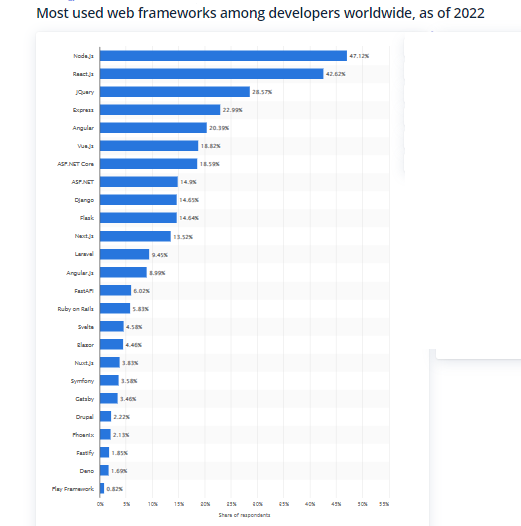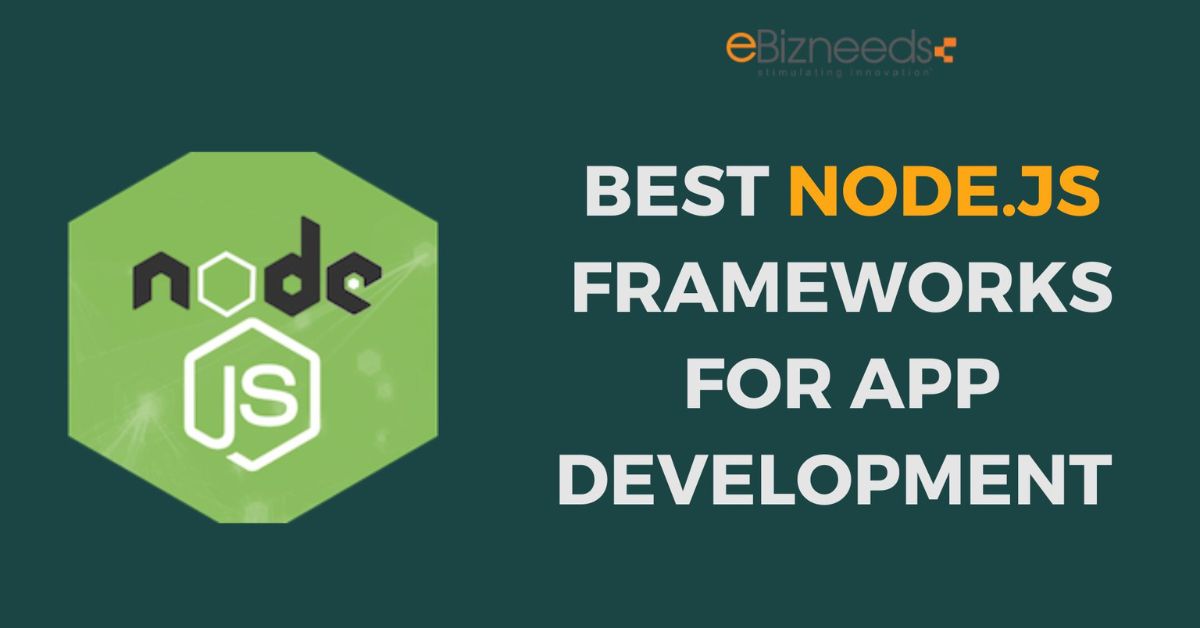Currently, the demand for mobile and web apps is rapidly increasing. Hence, app developers emphasize testing different frameworks to meet software development needs. NodeJS framework is emerged as a possible choice due to effective tooling, automation capabilities, templates, and libraries.
They are also sound for developers to overcome challenges with ease. But, selecting a NodeJS framework is a complex task because different platforms are available across the market. You don’t need to worry about it because this blog post will discuss the best Node.js frameworks for app development.
Before moving on to the main section of this blog, let’s delve deeper into the Node.js frameworks in detail.
What is Node.js Framework?
A Node.js framework is a set of different tools and libraries that are essential in the development procedure of a software app. It performs as a base wherein different software apps can be developed.
This framework is a workspace platform that assists in applying Node.js and permits the developers to use JavaScript to build an app’s front and back end.
Which JS Framework is Faster?
As of 2022, NodeJS has surpassed React.js as the most popular web platform among software engineers worldwide. 47.12% of respondents to the study said they utilise Node.js frameworks, whereas 42.62% use React.js.


Source: Statista, 2023
Benefits of Node.js
There are different benefits of using Node.js frameworks. In this section we’ve covered some of Node.js’ most important advantages.
Fast: Because it was created using Google Chrome’s V8 JavaScript engine, Node.js frameworks are quick.
Asynchronous: Node.js’s APIs all behave in an asynchronous, non-blocking manner. The web server is allowed to continue onto the next API once you request one. The Node.js framework takes into account a system of event alerts that enables the server to obtain feedback from previous API requests.
Single-threaded: Node.js frameworks rely on a single-threaded approach that takes event looping into account, in addition to the current prevalent concurrency paradigm of utilising OS threads. By using the event system, it enables the server to reply in a non-blocking way.
No Buffering: By not buffering any data or instead delivering app results in chunks, Node.js significantly reduces the process time required to upload video and audio files.
Criteria for Evaluation of Node.js Framework
Some of the recognized brands evaluate Node.js in current times. With that type of track record, you should wonder what makes Node.js so popular among the developer community. Let’s discuss some criteria for evaluating the Node.js framework.
Scalability
Users of Node.js frameworks are most possibly to be application-based startups. By using it, your business can build real-time mechanisms that are scalable, lightweight, along with highly performant.
Moreover, it is significant to integrate the new modules into your app to introduce new features, permitting you to expand your user base sets without sacrificing any of the app’s creativity.
Ease of Use
According to a 2016 user study by Node.js, among the most widely used languages for front-end building is JavaScript, with about 85% preferring it to other alternatives such as Ruby or Python.
This popular programming language framework offers the developer community an attractive mode to develop software apps and services for the current tech-driven world.
Due to its easy-to-adopt feature, several people learn Node.js Frameworks for App Development or other recognized use cases. This framework needs less effort and time to learn the language. Therefore, it is one of the significant benefits of node.js for developing efficient web apps.
Performance
Node.js frameworks provide high performance while contrasting to other server-side scripting languages. It makes an eye-catching option for different web developers.
For testing the performance of Node.js, you can try out multiple projects and contrast their speed with other server-side scripting languages such as PHP and Java.
Sometimes, it will be noticed that Node.js is faster than another server-side scripting language while responding to requests for website pages.
Community Support
Node.js framework emphasizes supporting a large and active community that is always willing to support any queries or problems you may face. It is globally-used tech that has influenced millions of developers to act on it and overcome the highly complex challenges across multiple industries, such as tech giants Microsoft or Google.
Therefore, it has support from an active and large community is a significant benefit of node.js.
What Are the Top Frameworks of Node.js
Here we will discuss Best JavaScript Frameworks for Node.js Development:
1. Hapi.js
It is a leading Node.js front-end framework that intermediates between the client and server. Moreover, it is intuitive, transparent, and easy to use.
|
Pros |
Cons |
| It is primarily intended for wider projects and larger teams. | It is not highly efficient for CPU-intensive applications. |
| It is configurable-rich, reliable, and stable. | |
| Hapi makes it easy to render dynamic content. | The coding speed was not as fast. |
| Scalability is considered with plugin-based architecture. | |
| It can be applied with Postgres, MySQL, and MongoDB to develop static and potential websites. |
Use Cases:
- Boodle
- Gozova
2. Express.js
It is a highly used framework and the initial choice of different developers. In addition, it provides both flexibility and speed.
Since Express is consistent and lightweight across the platform, it best fits mobile and web apps.
Let’s discuss some pros and cons of the Express.js framework.
|
Pros |
Cons |
| Quick server-side programming packages | As codebase size increases, refactoring is becoming a challenge. |
| Higher performance | All endpoints require to be developed manually. |
| Super-high test coverage | |
| Different HTTP helpers | |
| Effective content negotiation | Organizational clarity becomes all-essential. |
| MVC architectural structure |
Use Cases:
- BlaBlaCar
- Uber
- Accenture
3. Meteor.js
It is a full-stack JS platform for building contemporary mobile and web apps. In addition, real-time updates are a compelling benefit of Meteor.
A large community supports this framework, so tutorials, documentation, and learning methods are also easily accessible.
| Pros | Cons |
| Code writing in modern JS and Isomorphic framework | The lack of a native widget library. |
| Cross-platform framework, developing rapid prototyping with CLI | |
| An open-source framework, Wider community support | The absence of PWA support built-in. |
| Full-stack solution | |
| Rapid interaction and quick results | |
| Easy integration with other frameworks |
Use Cases:
- Mazda
- Accenture
- Deloitte
4. Derby.js
For contemporary applications, this is best Node.js Framework as it offers the whole stack. Data may be synchronized between clients and servers due to automated conflict resolution.
The DerbyJS module is a set of common Node.js modules offering capabilities with well-known programmes like npm and browserify. Many people think it’s the best option for creating real-time group apps.
|
Pros |
Cons |
| Designer-friendly HTML layouts allow code to be quickly transformed into elements and to appear on both devices and servers. | The community is smaller with Derby, and server-side rendering of views is not supported. These drawbacks make Derby less appealing. |
Use cases
- Single Music
- CrowdTwist
- Kiip
- Network
5. Total.js
Total.js is a speedy and reliable open-source platform that is fully complete. Thus, it is very adaptable, and many people utilize it for desktop and web-based and IoT apps. You can hire Node.js developers for implementing this framework.
|
Pros |
Cons |
| It is interoperable with numerous front-end and database platforms, and many of its advantages arise from its modular design. | Nevertheless, Eshop, one of Total’s versions, is used by many front-end developers when creating efficient content management systems. |
| Some unique capabilities include an image processing tool and an SMTP system. | However, there are several advantages to the modular design. However, it may also result in negative consequences like over-dependence and government.
|
Use Cases:
- Medium
- CapitalOne
- Trello
6. Nest.js
One of the many advanced Node.js backend framework that provide the finest developer experience is Nest.js. Because of its modular nature, developers may easily use many libraries.
With Nest.js at your fingertips, you have plenty of space to study the most recent JavaScript capabilities and create cutting-edge digital products. Its adaptability in creating various backend apps kinds increases its significance.
|
Pros |
Cons |
| FRP simplifies complicated graphical user interfaces (such as those in games or robotics) | Because NestJS employs Angular principles, it could be initially challenging for developers unfamiliar with Angular to understand NestJS. |
| CLI for a modular structure and functionality | |
| Simple learning curve | The community for NestJS is minimal in comparison to Express. |
| Easy-to-use third-party libraries owing to methodical code layout | |
| High compliance with Angular on the front-end |
Use Cases:
- Adidas
- Autodesk
- Neoteric
- Sanofi
7. Koa.js
Koa.js is best Node.js Framework that performs wonders when establishing various web services, often known as APIs. Creating such APIs using Koa is fun and simple since it effectively handles HTTP processing using a stack-like approach.
Furthermore, it actively normalizes Node defects. With this system, you may maintain distinct representations of the information for visitors with the same URL, such as translating a page, personalizing material on eCommerce websites, maintaining various photograph sizes, and much more.
Utilizing Koa has the added benefit of being somewhat comparable to Express. While developing code, you may still use Express’ versatility while having greater freedom and less complexity. By doing this, the app’s total stack of errors is kept to a minimum.
| Pros |
Cons |
| It is a futuristic framework that may be customized and is thought of as a lighter version of the Express | Less functionality |
| Excellent error handling | |
| Cascade middleware (Personalises user experience) | Incompatibility with middleware for the Node.js frameworks |
| Cleans cache provides proxy and content bargaining, normalizes node discrepancies, and aids in code maintenance | |
| Has additional customization options | Does not provide support for conventional middleware |
| Enables the creation of applications from beginning |
Use Cases
- Bulb
- GAPO 8
8. Socket.io
A quick and dependable full-stack system for creating real-time apps is socket.io. It is intended for two-way, real-time, event-driven communication.
It has features like auto-reconnection, disconnection detection, binary, multiplexing, and rooms. It operates on any operating system, browser, and device and features an easy-to-use API that balances speed with dependability.
| Pros |
Cons |
| It stands out for its endurance of the web, its app creation procedure, and immediate data analysis provides high-speed assistance. | Because Socket.io employs call-backs, there is no reply assurance to indicate that it has received a notification. Hence, to deal with such cases, we must develop specific logic for our app to handle them. |
| Although integrating the chat app is the biggest hurdle, developers may overcome these obstacles using this technology. | |
| The auto-identification of faults and their correction becomes simpler; it continues to monitor revisions and offer new capabilities. | |
| Both client-side and server-side programming may use comparable APIs. |
Use Cases
- Bepro
- Barogo
- Patreon
9. Loopback.js
You can rapidly construct APIs on top of your backend services with the LoopBack Node.js framework. It offers immediate interaction with upwards of 20 databases and offerings, including MongoDB, SOAP, REST, and more. The LoopBack models used by the Node and REST APIs are JavaScript objects.
When a model is formed, LoopBack automatically pre-defines a REST API with a full set of development, read, update, as well as delete activities. This is an essential and very helpful feature.
You can contact with mobile app development company to apply this best Node.js backend framework for app development.
| Pros |
Cons |
| It now has a fully new core rebuilt in TypeScript, making it simpler than ever to use and modify. | High learning curve |
| It now supports OpenAPI for a comprehensive bottom-up and top-down REST API experience. | Difficult to employ in large-scale projects |
| Enables the creation of instance GraphQL endpoints through REST APIs. | The monolithic design employs Cases |
Use Cases:
- United States Ministry of Energy
- GoDaddy
- Symantec
10. Sails.JS
Creating unique, business-grade Node applications using the constantly expanding Sails.js Node.js framework is simple.
Instead of worrying about managing servers and setups, we take responsibility for all the cumbersome infrastructure, allowing you to concentrate on creating your product. Sails.js’s concise API and excellent efficiency also make it easy to learn.
Sail is a Node. Js-based web framework that employs the MVC (Model View Controller) architectural pattern, allowing programmers to build scalable and reliable real-time applications. The MVC design is similar to Ruby on Rails-style frameworks. It also enables a more contemporary, data-driven approach to web apps and API design.
Sails.js can provide API bookstores. For example, you don’t need to create code since Sails provides simple designs.
| Pros |
Cons |
| Support for Socket.io | Poor administration |
| Incredible built-in capabilities | A slow framework |
| Data storage at any place | Lengthy development |
| Quick API design procedure | |
| Separation of business logic and user interface | A lack of access to all of Node.js’s APIs |
| Free production of JSON API |
Use cases
- Technologies for lithium
- Greendeck
11. Fastify
It is a web platform that is quick and efficient. Its primary goal is to provide the greatest user experience possible with the least overhead and a robust plugin architecture that Hapi and Express influence.
Fastify focuses on several attributes and ideas. As the name implies, it focuses on speed and can handle up to 30,000 demands per second. It is widely acknowledged to offer extensibility through plugins, hooks, and decorators. The framework is user-friendly for developers, emphasizing expressive codes that don’t compromise performance or security.
|
Pros |
Cons |
| You may use Fastify design from a reputable business, Radixweb, to add these special capabilities. | The community for Fastify is small. Thus, you may have to repair the problem manually if you’re stuck with it. |
| Fastify is extendable via its hook, plugins, as well as decorators. It is considered to be one of the fastest web platforms. | Fastify adheres to the collaborative ownership philosophy, allowing you to publish a PR and benefit the community. |
| The platform is designed to be extremely flexible and to aid developers in daily tasks without sacrificing security and speed. |
Use Cases:
- Microsoft
- Hotstar
- Future Foundry
Comparison of Node.js and React.js
Let’s discuss the comparison between Node.js vs React.js.
|
Feature |
Node.js |
React.js |
| Definition | JavaScript code may be executed outside a browser using an open-source, cross-platform execution context. | A JavaScript package that is free and open-source that is used to create user interfaces or UI elements. |
| Type | Server-side runtime environment | Client-side UI library |
| Language | JavaScript | JavaScript |
| Developed By | Ryan Dahl | |
| First Released | 2009 | 2013 |
| Used for | Development of the back-end, creation of APIs, networking apps, real-time apps, and microservices, among other things. | Designing user interfaces, creating reusable UI components, developing SPAs, creating mobile applications, etc. |
| Scalability | High scalability as a result of its event-driven design and non-blocking I/O approach. | Because of its component-based architecture and virtual DOM, it is very scalable. |
| Performance | High performance as a result of its event-driven design and non-blocking I/O approach. | High performance because of the virtual DOM and the effective rendering strategy. |
| Community | A large and vibrant community that offers a variety of libraries and tools. | A large and vibrant community with an extensive selection of libraries and tools. |
| Learning Curve | Due to its event-driven design and asynchronous programming paradigm, there is a moderate to high learning curve. | The learning curve is moderate to high because of its event-driven architecture and asynchronous programming philosophy. |
| Popularity | Widely employed and well-liked among programmers. | Commonly utilized and well-liked among front-end developers. |
| Frameworks | Express, Koa, Nest.js, Hapi, etc. | Next.js, Gatsby.js, Redux, MobX, etc. |
| Licensing | MIT | MIT |
Note: It’s crucial to remember that Node.js and React.js cannot be directly compared since they have distinct roles inside the development stack. React.js is more often utilized for front-end development than Node.js is for server-side development.
Which Framework is Best for Different Types of Projects?
The popular and potent JavaScript runtime framework Node.js is often used to create various online applications, including real-time networking, microservices, and APIs.
Here are some explanations for why the Node.js framework is preferred over alternative frameworks for certain projects:
High Scalability
The event-based, non-blocking I/O mechanism that Node.js is built on makes it very scalable. It is appropriate for creating highly scalable apps since it can manage several simultaneous connections without hindering or slowing down the server.
Performance
Because of its non-blocking I/O paradigm and event-driven design, Node.js is renowned for its excellent speed. It is perfect for creating high-performance applications since it can swiftly and effectively manage many requests.
JavaScript
Because Node.js is built in JavaScript, it is simple for programmers to use the same language when working on the front-end and backend of a web app. It shortens the development process while making a program easier to maintain since developers may utilize the same language and distribute code across the frontend and backends.
Large and Active Community
A strong and vibrant developer community supports the expansion of Node.js framework and builds new libraries and plugins to expand its capability. This group offers programmers assistance, materials, and tools to facilitate and speed up development.
Rich Ecosystem
Node.js has an extensive collection of libraries and modules, which makes it simple for developers to add additional functionality and features to their apps. Tools for creating APIs, apps that operate in real-time, microservices, and other technologies are available in this ecosystem.
Cross-Platform Support
Because Node.js is cross-platform, it can be used with Windows, macOS, and Linux. It makes developing and deploying apps across many platforms and environments simple.
Overall, Node.js is a flexible and strong framework that provides developers with several advantages, including cross-platform compatibility, scalability, performance, and JavaScript compatibility.
Due to these characteristics, it is one of the most well-liked and often used frameworks in modern web development and an excellent option for various projects. You can consult with Node.js development company to use best Node.js framework for app development.
Conclusion
To sum up, Node.js is a well-liked and effective JavaScript runtime framework often used to create different kinds of online applications. Several Node.js frameworks help programmers create scalable, fast-performing, and feature-rich apps. Scalability, speed, usability, modularity, and extensibility are just a few of the characteristics and advantages these Node.js frameworks provide.
Under their project needs, development expertise, and personal choices, developers may choose the ideal framework. As a whole, Node.js frameworks offer programmers the resources and capabilities they require to create cutting-edge, scalable web apps quickly and effectively.



Naveen Khanna is the CEO of eBizneeds, a company renowned for its bespoke web and mobile app development. By delivering high-end modern solutions all over the globe, Naveen takes pleasure in sharing his rich experiences and views on emerging technological trends. He has worked in many domains, from education, entertainment, banking, manufacturing, healthcare, and real estate, sharing rich experience in delivering innovative solutions.






